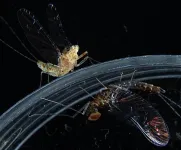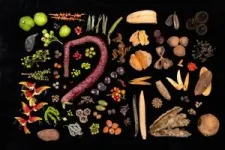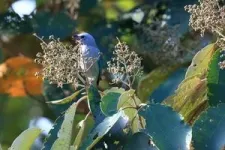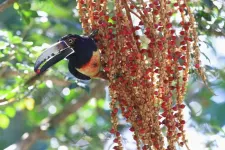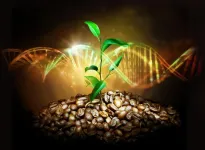(Press-News.org) 700 million years ago, a remarkable creature emerged for the first time. Though it may not have been much to look at by today’s standards, the animal had a front and a back, a top and a bottom. This was a groundbreaking adaptation at the time, and one which laid down the basic body plan which most complex animals, including humans, would eventually inherit.
The inconspicuous animal resided in the ancient seas of Earth, likely crawling along the seafloor. This was the last common ancestor of bilaterians, a vast supergroup of animals including vertebrates (fish, amphibians, reptiles, birds, and mammals), and invertebrates (insects, arthropods, molluscs, worms, echinoderms and many more).
To this day, more than 7,000 groups of genes can be traced back to the last common ancestor of bilaterians, according to a study of 20 different bilaterian species including humans, sharks, mayflies, centipedes and octopuses. The findings were made by researchers at the Centre for Genomic Regulation (CRG) in Barcelona and are published today in the journal Nature Ecology and Evolution.
Remarkably, the study found that around half of these ancestral genes have since been repurposed by animals for use in specific parts of the body, particularly in the brain and reproductive tissues. The findings are surprising because ancient, conserved genes usually have fundamental, important jobs that are needed in many parts of the body.
When the researchers took a closer look, they found a series of serendipitous ‘copy paste’ errors during bilaterian evolution were to blame. For example, there was a significant moment early in the history of vertebrates. A bunch of tissue-specific genes first appeared coinciding with two whole genome duplication events. Animals could keep one copy for fundamental functions, while the second copy could be used as raw material for evolutionary innovation. Events like these, at varying degrees of scale, occurred constantly throughout the bilaterian evolutionary tree.
“Our genes are like a vast library of recipes that can be cooked up differently to create or change tissues and organs. Imagine you end up with two copies of a recipe for paella by accident. You can keep and enjoy the original recipe while evolution tweaks the extra copy so that it makes risotto instead. Now imagine the entire recipe book is copied – twice - and the possibilities it opens for evolution. The legacy of these events, which took place hundreds of millions of years ago, lives on in most complex animals today,” explains Federica Mantica, author of the paper and researcher at the Centre for Genomic Regulation (CRG) in Barcelona.
The authors of the study found many examples of new, tissue-specific functions made possible by the specialisation of these ancestral genes. For example, the TESMIN and tomb genes, which originated from the same ancestor, ended up independently playing a specialised role in the testis both in vertebrates and insects. Their importance is highlighted by the fact that problems with these genes can disrupt sperm production, affecting fertility in both mice and fruit flies.
The specialisation of ancestral genes also laid some foundations for the development of complex nervous systems. For example, in vertebrates, the researchers found genes critical for the formation of myelin sheaths around nerve cells, which are essential for fast nerve signal transmission. In humans they also identified FGF17, which is thought to play an important role in maintaining cognitive functions into old age.
In insects, specific genes became specialised in muscles and in the epidermis for cuticle formation, contributing to their ability to fly. In the skin of octopuses, other genes became specialised to perceive light stimulI, contributing to their ability to change colour, camouflage and communicate with other octopuses.
By studying the evolution of species at the tissue level, the study demonstrates that changes in the way genes are used in different parts of the body have played a big role in creating new and unique features in animals. In other words, when genes start acting in specific tissues, it can lead to the development of new physical traits or abilities, which ultimately contributes to animal evolution.
“Our work makes us rethink the roles and functions that genes play. It shows us that genes that are crucial for survival and have been preserved through millions of years can also very easily acquire new functions in evolution. It reflects evolution's balancing act between preserving vital roles and exploring new paths,” concludes ICREA Research Professor Manuel Irimia, co-author of the paper and researcher at the Centre for Genomic Regulation.
END
Evolution's recipe book: How ‘copy paste’ errors cooked up the animal kingdom
Insect flight, octopus camouflage and human cognition are three examples of evolutionary innovation which relied, in part, on gene duplication events hundreds of millions of years ago
2024-04-15
ELSE PRESS RELEASES FROM THIS DATE:
Switch to green wastewater infrastructure could reduce emissions and provide huge savings according to new research
2024-04-15
Embargo: This journal article is under embargo until April 15 at 10 a.m. BST/London (5 a.m. EDT/3 a.m. MDT). Media may conduct interviews around the findings in advance of that date, but the information may not be published, broadcast, or posted online until after the release window. Journalists are permitted to show papers to independent specialists under embargo conditions, solely for the purpose of commenting on the work described
University researchers have shown that a transition to green wastewater-treatment approaches in the U.S. that leverages the potential of carbon-financing could save a staggering $15.6 billion and just under 30 million tonnes of CO2-equivalent emissions ...
Specific nasal cells protect against COVID-19 in children
2024-04-15
Important differences in how the nasal cells of young and elderly people respond to the SARS-CoV-2 virus, could explain why children typically experience milder COVID-19 symptoms, finds a new study led by researchers at UCL and the Wellcome Sanger Institute.
The study, published in Nature Microbiology, focused on the early effects of SARS-CoV-2 infection on the cells first targeted by the viruses, the human nasal epithelial cells (NECs).
These cells were donated from healthy participants from Great Ormond Street Hospital (GOSH), University College London Hospital (UCLH) and the Royal ...
Tropical forests can't recover naturally without fruit eating birds
2024-04-15
New research from the Crowther Lab at ETH Zurich illustrates a critical barrier to natural regeneration of tropical forests. Their models – from ground-based data gathered in the Atlantic Forest of Brazil - show that when wild tropical birds move freely across forest landscapes, they can increase the carbon storage of regenerating tropical forests by up to 38 percent.
Birds seed carbon potential
Fruit eating birds such as the Red-Legged Honeycreeper, Palm Tanager, or the Rufous-Bellied Thrush play a vital role in forest ecosystems by consuming, excreting, and ...
Newly sequenced genome reveals coffee’s prehistoric origin story — and its future under climate change
2024-04-15
BUFFALO, N.Y. — The key to growing coffee plants that can better resist climate change in the decades to come may lie in the ancient past.
Researchers co-led by the University at Buffalo have created what they say is the highest quality reference genome to date of the world’s most popular coffee species, Arabica, unearthing secrets about its lineage that span millennia and continents.
Their findings, published today in Nature Genetics, suggest that Coffea arabica developed more than 600,000 years ago in the forests of Ethiopia ...
Human muscle map reveals how we try to fight effects of ageing
2024-04-15
How muscle changes with ageing, and tries to fight its effects, is now better understood at the cellular and molecular level with the first comprehensive atlas of ageing muscles in humans.
Researchers from the Wellcome Sanger Institute and their collaborators at Sun Yat-sen University, China applied single-cell technologies and advanced imaging to analyse human skeletal muscle samples from 17 individuals across the adult lifespan. By comparing the results, they shed new light on the many complex processes underlying age-related muscle changes.
The atlas, published ...
Study shows key role of physical activity and body mass in lung function growth in childhood
2024-04-15
A new study led by the Barcelona Institute for Global Health (ISGlobal), a centre supported by the "la Caixa" Foundation, sheds light on the growth of lung function in children. The results show that increased levels of physical activity and a higher body mass index (BMI) play a key role in the recovery of early deficits. These findings, published in the journal Thorax, have important implications for clinical practice, research and public health policy, providing new insights into how to improve respiratory health from childhood to adulthood.
The study analysed data from the ...
Security vulnerability in browser interface allows computer access via graphics card
2024-04-15
Modern websites place ever greater demands on the computing power of computers. For this reason, web browsers have also had access to the computing capacities of the graphics card (Graphics Processing Unit or GPU) in addition to the CPU of a computer for a number of years. The scripting language JavaScript can utilise the resources of the GPU via programming interfaces such as WebGL and the new WebGPU standard. However, this harbours risks. Using a website with malicious JavaScript, researchers from the Institute of Applied Information Processing and Communications at Graz University of Technology (TU Graz) were able to spy on information about data, keystrokes and encryption ...
Physical activity reduces stress-related brain activity to lower cardiovascular disease risk
2024-04-15
Key Takeaways
Results from a new study indicate that physical activity may help protect against cardiovascular disease in part by reducing stress-related brain activity
This effect in the brain may help to explain why study participants with depression (a stress-related condition) experienced the greatest cardiovascular benefits from physical activity.
BOSTON – New research indicates that physical activity lowers cardiovascular disease risk in part by reducing stress-related signaling in the brain.
In the study, which was led by investigators at Massachusetts General Hospital (MGH), a founding member of the Mass General Brigham healthcare ...
Inaugural International COSPAR Planetary Protection Week: Set to inspire global collaboration in London
2024-04-15
With an increasing number of space missions targeting various celestial bodies, including Mars, Europa, and the Moon, the importance of maintaining the integrity of these environments while protecting our own biosphere has never been greater. The ICPPW will serve as a platform for promoting international collaboration and knowledge exchange on best practice in planetary protection.
The event will feature a range of sessions, meetings, as well as panel discussions, covering key topics such as the current and ...
A quarter of deaths among young adults in Canada were opioid related in 2021
2024-04-15
Premature deaths related to opioids doubled between 2019 and 2021 across Canada, with more than 1 in 4 deaths among young adults aged 20–39 years attributable to opioids, according to new research published in CMAJ (Canadian Medical Association Journal) https://www.cmaj.ca/lookup/doi/10.1503/cmaj.231339.
Opioid-related deaths have continued to increase over the past decade across Canada, with 6222 deaths occurring in 2021. This trend worsened during the COVID-19 pandemic, although the scale and rapidity of increases varied across provinces and territories. ...
LAST 30 PRESS RELEASES:
Norbert Holtkamp appointed director of Fermi National Accelerator Laboratory
New agentic AI platform accelerates advanced optics design
Biologists discover neurons use physical signals — not electricity — to stabilize communication
Researchers discover that a hormone can access the brain by hitchhiking
University of Oklahoma researcher awarded funding to pursue AI-powered material design
Exploring how the visual system recovers following injury
Support for parents with infants at pediatric check-ups leads to better reading and math skills in elementary school
Kids’ behavioral health is a growing share of family health costs
Day & night: Cancer disrupts the brain’s natural rhythm
COVID-19 vaccination significantly reduces risk to pregnant women and baby
The role of vaccination in maternal and perinatal outcomes associated with COVID-19 in pregnancy
Mayo Clinic smartwatch system helps parents shorten and defuse children's severe tantrums early
Behavioral health spending spikes to 40% of all children’s health expenditures, nearly doubling in a decade
Digital cognitive behavioral treatment for generalized anxiety disorder
Expenditures for pediatric behavioral health care over time and estimated family financial burden
Air conditioning in nursing homes and mortality during extreme heat
The Alps to lose a record number of glaciers in the next decade
What makes a good proton conductor?
New science reporting guide published for journalists in Bulgaria
New international study reveals major survival gaps among children with cancer
New science reporting guide published for journalists in Turkey
Scientists develop a smarter mRNA therapy that knows which cells to target
Neuroanatomy-informed brain–machine hybrid intelligence for robust acoustic target detection
Eight SwRI hydrogen projects funded by ENERGYWERX
The Lundquist Institute and its start-up company Vitalex Biosciences Announces Strategic Advancement of Second-Generation fungal Vaccine VXV-01 through Phase 1 Trials under $40 Million Competitive Con
Fine particles in pollution are associated with early signs of autoimmune disease
Review article | Towards a Global Ground-Based Earth Observatory (GGBEO): Leveraging existing systems and networks
Penn and UMich create world’s smallest programmable, autonomous robots
Cleveland researchers launch first major study to address ‘hidden performance killer’ in athletes
To connect across politics, try saying what you oppose
[Press-News.org] Evolution's recipe book: How ‘copy paste’ errors cooked up the animal kingdomInsect flight, octopus camouflage and human cognition are three examples of evolutionary innovation which relied, in part, on gene duplication events hundreds of millions of years ago
